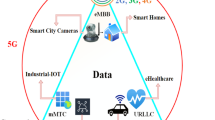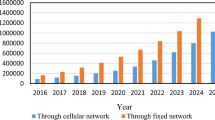Abstract
In the last decade, many fact-findings have been given on the performance analysis of composite fading channels in wireless communication. Various literatures have presented the performance analysis which includes shaping and severity factors of the multipath and shadowing simultaneously. But very limited amount of literature has included above factors in the path of desired users and interferers both. However, this paper present various closed form expressions of average capacity and symbol error rates (SER) over generic composite fading channel by considering shaping and severity parameters of the multipath and shadowing simultaneously, not only in the desired but in the interfering path as well. Specifically, closed form expressions for average capacity with equal gain combining/maximal ratio combining (MRC) and without diversity scheme have been presented. SER of M-ary phase shift keying and M-ary quadrature amplitude modulation scheme under MRC diversity scheme has been also presented. Moreover, in this paper, performance degradation for interferers and performance improvement for desired users have been researched by decreasing the value of severity of either multipath or shadowing in the path of interferers and desired users respectively. All the proposed results have been numerically compared with the available literatures, showing the perfect agreement.







Similar content being viewed by others
References
Li, J., Song, J. B., & Han, Z. (2013). Network connectivity optimization for device-to-device wireless system with femtocells. IEEE Transactions on Vehicular Technology,62(7), 3098–3109.
Chandrasekhar, V., Andrews, J. G., & Gatherer, A. (2008). Femtocell networks: A survey. IEEE Communications Magazine,46(9), 59–67.
Andrews, J. G., Claussen, H., Dohler, M., Rangan, S., & Reed, M. C. (2012). Femtocells: Past, present, and future. IEEE Journal on Selected Areas in Communications,30(3), 497–508.
Kumar, S. (2015). Wireless communication the fundamental and advance concepts. Aalborg: River Publishers.
Cheng, S. M., Lien, S. Y., Chu, F. S., & Chen, K. C. (2011). On exploiting cognitive radio to mitigate interference in macro/femto heterogeneous networks. IEEE Wireless Communications,18(3), 40–47.
Collonge, S., Zaharia, G., & Zein, G. E. (2004). Influence of the human activity on wide-band characteristics of the 60 GHz indoor radio channel. IEEE Transactions on Wireless Communication,3(6), 2396–2406.
Obayashi, S., & Zander, J. (1998). A body-shadowing model for indoor radio communication environments. IEEE Transactions on Antennas and Propagation,46(6), 920–927.
Geng, S., Kivinen, J., Zhao, X., & Vainikainen, P. (2009). Millimetre-wave propagation channel characterization for short-range wireless communications. IEEE Transactions on Vehicular Technology,58(1), 3–13.
Yilmaz, F., & Alouini, M. S. (2010). Extended generalized-K (EGK): A new simple and general model for composite fading channels. IEEE Transactions on Communication. arXiv preprint. https://arxiv.org/pdf/1012.2598.
Peppas, K. P. (2012). A new formula for the average bit error probability of dual-hop amplify-and-forward relaying systems over generalized shadowed fading channels. IEEE Wireless Communications Letters,1(2), 85–88.
Peppas, K. P., Zamkotsian, M., Lazarakis, F., & Cottis, P. G. (2013). Unified error performance analysis of space shift keying modulation for MISO and MIMO systems under generalized fading. IEEE Wireless Communications Letters,2(6), 663–666.
Peppas, K. P., Zamkotsian, M., Lazarakis, F., & Cottis, P. G. (2014). Asymptotic error performance analysis of spatial modulation under generalized fading. IEEE Wireless Communications Letters,3(4), 421–424.
Yilmaz, F., & Alouini, M. S. (2010). A new simple model for composite fading channels: Second order statistics and channel capacity. In Wireless communication systems (ISWCS), 2010 7th international symposium on (pp. 676–680). IEEE.
Yilmaz, F., & Alouini, M. S. (2012). A novel unified expression for the capacity and bit error probability of wireless communication systems over generalized fading channels. IEEE Transactions on Communications,60(7), 1862–1876.
Alhennawi, H. R., Ismail, M. H., & Mourad, H. A. (2014). Performance evaluation of energy detection over extended generalised-${\cal K} $ K composite fading channels. Electronics Letters,50(22), 1643–1645.
Shankar, P. M. (2012). Fading and shadowing in wireless system. New York, NY: Springer.
Hamdi, K. A. (2008). Capacity of MRC on correlated Rician fading channels. IEEE Transactions on Communications,56(5), 708–711.
Palat, R. C., Annamalai, A., & Reed, J. H. (2008). An ancient method for evaluating information outage probability and ergodic capacity of OSTBC system. IEEE Communications Letters,12(3), 191–193.
Renzo, M. D., Graziosi, F., & Santucci, F. (2010). Channel capacity over generalized fading channels: A novel MGF-based approach for performance analysis & design of wireless communication systems. IEEE Transactions on Vehicular Technology,59(1), 127–149.
Yilmaz, F., & Alouini, M. S. (2012). A unified MGF-based capacity analysis of diversity combiners over generalized fading channels. IEEE Transactions on Communication,60(03), 1–26.
Anastasov, J. A., Djordjevic, G. T., & Stefanovic, M. C. (2012). Analytical model for outage probability of interference-limited systems over extended generalized-K fading channels. IEEE Communications Letters,16(4), 473–475.
Prudnikov, A. P., Brychkov, Y. A., & Marichev, O. I. (1990). Integral and series: Volume 3, More Special Functions. New York: CRC Press Inc.
Kilbas, A., & Saigo, M. (2004). H-transforms: Theory and applications. Boca Raton, FL: CRC Press LLC.
Shin, H., & Lee, J. H. (2004). On the error probability of binary and M-ary Signals in Nakagami-m fading channels. IEEE Transactions on Communication,52(4), 536–539.
Chen, Y., & Beaulieu, N. C. (2009). A simple polynomial approximation to the Gaussian Q-function and its application. IEEE Communications Letters,13(2), 124–126.
Singh, S. P., & Kumar, S. (2016). A MGF based closed form expressions for error probability and capacity over EGK fading for interference limited system. Wireless Personal Communications,91(2), 577–593.
Simon, M. K., & Alouini, M.-S. (2005). Digital communication over fading channels. New York: Wiley.
Hasan, M. I., & Kumar, S. (2017). Spectral efficiency of dual diversity selection combining schemes under correlated Nakagami-0.5 fading with unequal average received SNR. Telecommunication Systems,64(1), 3–16.
Singh, S. P., & Kumar, S. (2017). Closed form expressions for ABER and capacity over EGK fading channel in presence of CCI. International Journal of Electronics,104(3), 513–527.
Author information
Authors and Affiliations
Corresponding author
Additional information
Publisher's Note
Springer Nature remains neutral with regard to jurisdictional claims in published maps and institutional affiliations.
Rights and permissions
About this article
Cite this article
Singh, S.P., Kumar, A., Mishra, S. et al. Closed Form Expressions for Average Capacity and Symbol Error Rates Under Different Diversity Techniques Over EGK Fading Under Interference. Wireless Pers Commun 113, 2477–2498 (2020). https://doi.org/10.1007/s11277-020-07337-8
Published:
Issue Date:
DOI: https://doi.org/10.1007/s11277-020-07337-8




